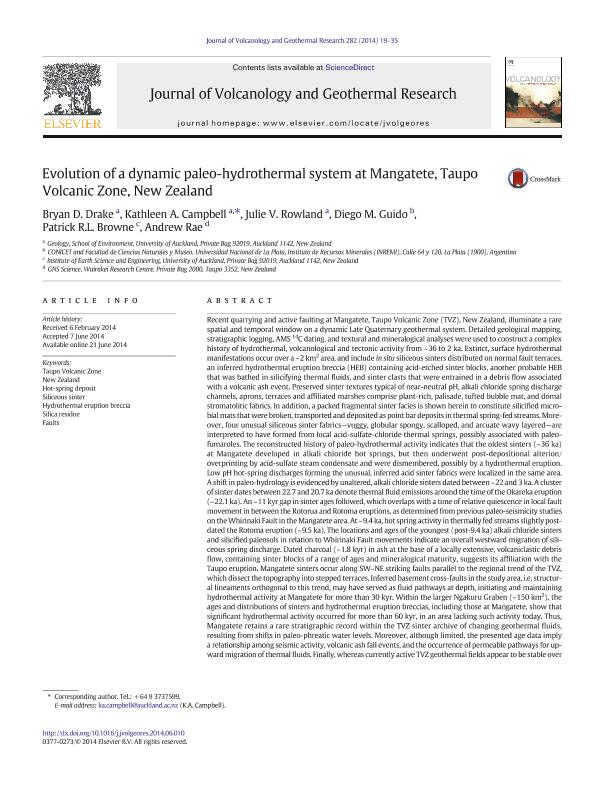Artículo
Evolution of a dynamic paleo-hydrothermal system at Mangatete, Taupo Volcanic Zone, New Zealand
Drake, Bryan D.; Campbell, Kathleen; Rowland, Julie V.; Guido, Diego Martin ; Browne, Patrick R. L.; Rae, Andrew
; Browne, Patrick R. L.; Rae, Andrew
 ; Browne, Patrick R. L.; Rae, Andrew
; Browne, Patrick R. L.; Rae, Andrew
Fecha de publicación:
06/2014
Editorial:
Elsevier Science
Revista:
Journal of Volcanology and Geothermal Research
ISSN:
0377-0273
Idioma:
Inglés
Tipo de recurso:
Artículo publicado
Clasificación temática:
Resumen
Recent quarrying and active faulting at Mangatete, Taupo Volcanic Zone (TVZ), New Zealand, illuminate a rare spatial and temporal window on a dynamic Late Quaternary geothermal system. Detailed geological mapping, stratigraphic logging, AMS 14C dating, and textural and mineralogical analyses were used to construct a complex history of hydrothermal, volcanological and tectonic activity from ~ 36 to 2 ka. Extinct, surface hydrothermal manifestations occur over a ~ 2 km2 area, and include in situ siliceous sinters distributed on normal fault terraces, an inferred hydrothermal eruption breccia (HEB) containing acid-etched sinter blocks, another probable HEB that was bathed in silicifying thermal fluids, and sinter clasts that were entrained in a debris flow associated with a volcanic ash event. Preserved sinter textures typical of near-neutral pH, alkali chloride spring discharge channels, aprons, terraces and affiliated marshes comprise plant-rich, palisade, tufted bubble mat, and domal stromatolitic fabrics. In addition, a packed fragmental sinter facies is shown herein to constitute silicified microbial mats that were broken, transported and deposited as point bar deposits in thermal spring-fed streams. Moreover, four unusual siliceous sinter fabrics—vuggy, globular spongy, scalloped, and arcuate wavy layered—are interpreted to have formed from local acid-sulfate-chloride thermal springs, possibly associated with paleo-fumaroles. The reconstructed history of paleo-hydrothermal activity indicates that the oldest sinters (~ 36 ka) at Mangatete developed in alkali chloride hot springs, but then underwent post-depositional alterion/overprinting by acid-sulfate steam condensate and were dismembered, possibly by a hydrothermal eruption. Low pH hot-spring discharges forming the unusual, inferred acid sinter fabrics were localized in the same area. A shift in paleo-hydrology is evidenced by unaltered, alkali chloride sinters dated between ~ 22 and 3 ka. A cluster of sinter dates between 22.7 and 20.7 ka denote thermal fluid emissions around the time of the Okareka eruption (~ 22.1 ka). An ~ 11 kyr gap in sinter ages followed, which overlaps with a time of relative quiescence in local fault movement in between the Rotorua and Rotoma eruptions, as determined from previous paleo-seismicity studies on the Whirinaki Fault in the Mangatete area. At ~ 9.4 ka, hot spring activity in thermally fed streams slightly post-dated the Rotoma eruption (~ 9.5 ka). The locations and ages of the youngest (post-9.4 ka) alkali chloride sinters and silicified paleosols in relation to Whirinaki Fault movements indicate an overall westward migration of siliceous spring discharge. Dated charcoal (~ 1.8 kyr) in ash at the base of a locally extensive, volcaniclastic debris flow, containing sinter blocks of a range of ages and mineralogical maturity, suggests its affiliation with the Taupo eruption. Mangatete sinters occur along SW–NE striking faults parallel to the regional trend of the TVZ, which dissect the topography into stepped terraces. Inferred basement cross-faults in the study area, i.e. structural lineaments orthogonal to this trend, may have served as fluid pathways at depth, initiating and maintaining hydrothermal activity at Mangatete for more than 30 kyr. Within the larger Ngakuru Graben (~ 150 km2), the ages and distributions of sinters and hydrothermal eruption breccias, including those at Mangatete, show that significant hydrothermal activity occurred for more than 60 kyr, in an area lacking such activity today. Thus, Mangatete retains a rare stratigraphic record within the TVZ sinter archive of changing geothermal fluids, resulting from shifts in paleo-phreatic water levels. Moreover, although limited, the presented age data imply a relationship among seismic activity, volcanic ash fall events, and the occurrence of permeable pathways for upward migration of thermal fluids. Finally, whereas currently active TVZ geothermal fields appear to be stable over tens of thousands of years or more, the fossil hydrothermal systems in the wider Mangatete area demonstrate the possibility of much greater temporal variability in the lateral expression of local surface manifestations of thermal fluid discharge through time.
Archivos asociados
Licencia
Identificadores
Colecciones
Articulos(CCT - LA PLATA)
Articulos de CTRO.CIENTIFICO TECNOL.CONICET - LA PLATA
Articulos de CTRO.CIENTIFICO TECNOL.CONICET - LA PLATA
Citación
Rae, Andrew; Browne, Patrick R. L.; Guido, Diego Martin; Rowland, Julie V.; Campbell, Kathleen; Drake, Bryan D.; et al.; Evolution of a dynamic paleo-hydrothermal system at Mangatete, Taupo Volcanic Zone, New Zealand; Elsevier Science; Journal of Volcanology and Geothermal Research; 282; 6-2014; 19-35
Compartir
Altmétricas



